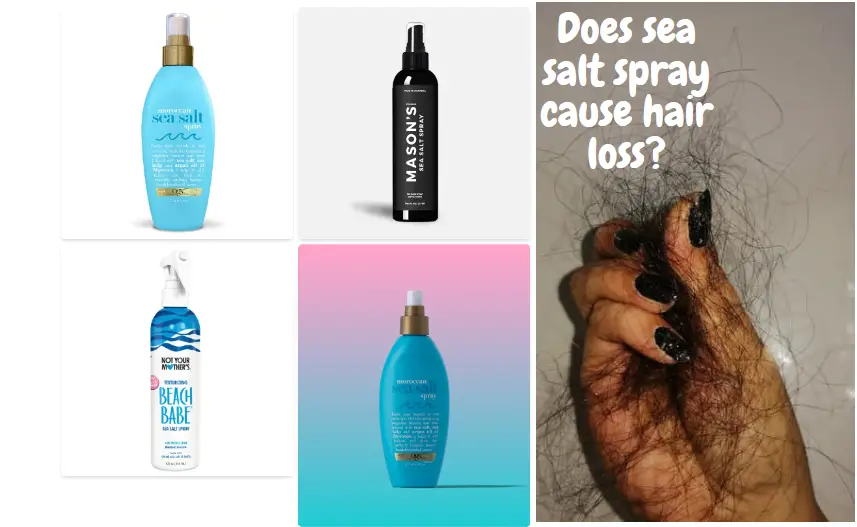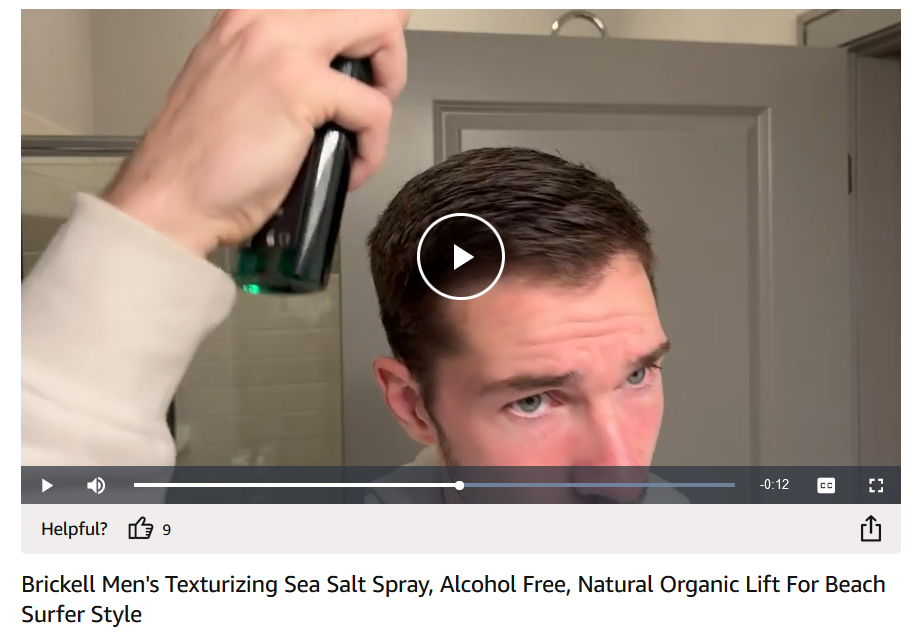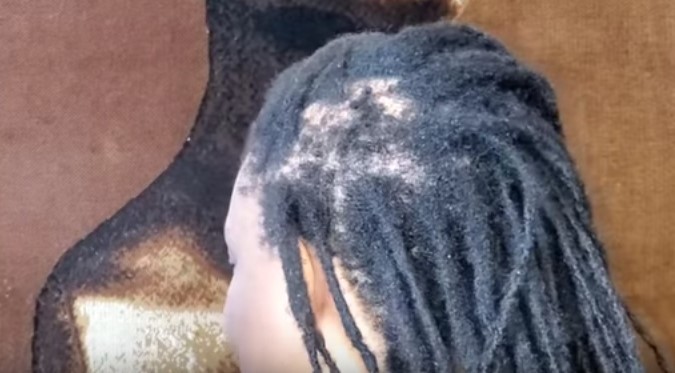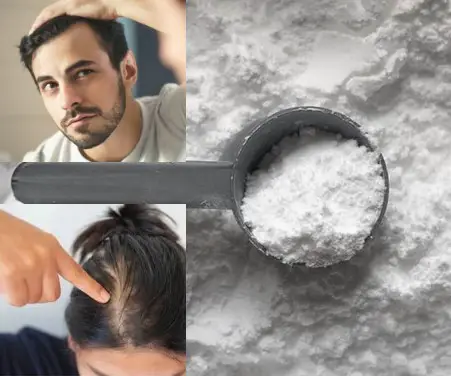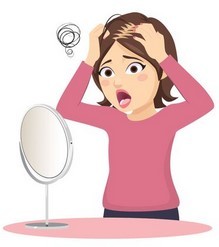Discover the truth about does sea salt spray cause hair loss. Uncover the science behind sea salt sprays, learn effective application techniques, and explore natural alternatives for textured hair. Dive into FAQs and key takeaways for healthy, beachy waves.
In recent years, the beauty and grooming industry has seen a surge in the popularity of sea salt sprays. These sprays promise to give your hair that perfect beachy wave, mimicking the effects of a day spent by the ocean. But with this rise in popularity comes a wave of questions and concerns. Does sea salt spray cause hair loss? Is it safe for daily use? How does it interact with different hair types?
Personal anecdote: I remember the first time I used a sea salt spray. It was during a vacation in Hawaii. After a day at the beach, I loved how my hair looked – tousled, wavy, and full of volume. Wanting to replicate that look back home, I purchased my first bottle of sea salt spray. The results were fantastic, but I couldn’t help but wonder about the long-term effects of using it regularly.
Benefits of Sea Salt Spray:
-
- Texture and Volume: Achieve that coveted beachy wave look.
- Natural Ingredients: Often free from harmful chemicals.
- Versatility: Suitable for various hair types and styles.
However, as with all products, it’s essential to understand the potential side effects and how to use them effectively. This article delves deep into the world of sea salt sprays, addressing common concerns and providing actionable insights.
Wondering about other causes of hair loss? Check out our comprehensive guide on the stages of balding.
In the next section, we’ll explore the rise of sea salt sprays, their benefits, and potential side effects. If you’ve ever pondered the question, “can sea salt spray cause hair loss?“, you’re in the right place. Let’s dive in!
Curious about the effects of other hair products? Discover if Native shampoo can lead to hair loss.
The Rise of Sea Salt Sprays
The beauty and grooming world is ever-evolving, with new products emerging almost daily. Among these, sea salt sprays have carved a niche for themselves, becoming a staple for many in their hair care routine. These sprays, known for imparting that coveted beachy wave look, have garnered attention and intrigue from both everyday users and hairstyling professionals.
Personal anecdote: A couple of years ago, during a summer trip to the Maldives, I noticed a distinct change in my hair after a day at the beach. The saltwater gave my usually flat hair a voluminous, wavy texture that I absolutely loved. On returning, I was introduced to sea salt sprays by a hairstylist friend, and it felt like I had the beach in a bottle!
But what exactly has led to the meteoric rise of these sprays?
- Natural Look and Feel: In an era where the ‘no makeup’ makeup look reigns supreme, the natural, tousled effect of sea salt sprays is a winner.
- Ease of Use: A few spritzes on damp hair, and you’re good to go. No need for multiple products or tools.
- Versatility: Whether you have straight, wavy, or curly hair, sea salt sprays can enhance your natural texture.
However, as with all things popular, there’s a flip side. Questions have arisen about the long-term effects of these sprays. Does sea salt spray cause hair thinning? Is it suitable for all hair types?
| Pros | Cons |
|---|---|
| Adds volume and texture | Can lead to hair dehydration |
| Natural ingredients | Might strip natural oils |
| Suitable for various hair types | Potential for scalp irritation |
Have you ever wondered about the different stages of balding crown? Dive deep into our comprehensive guide to understand more.
In the upcoming sections, we’ll delve deeper into the potential side effects and benefits of sea salt sprays. We aim to provide a balanced view, helping you make an informed decision about incorporating these sprays into your routine.
Before we move on, if you’re curious about other hair products and their effects, discover if hairspray can lead to hair loss here.
What is Sea Salt Spray?
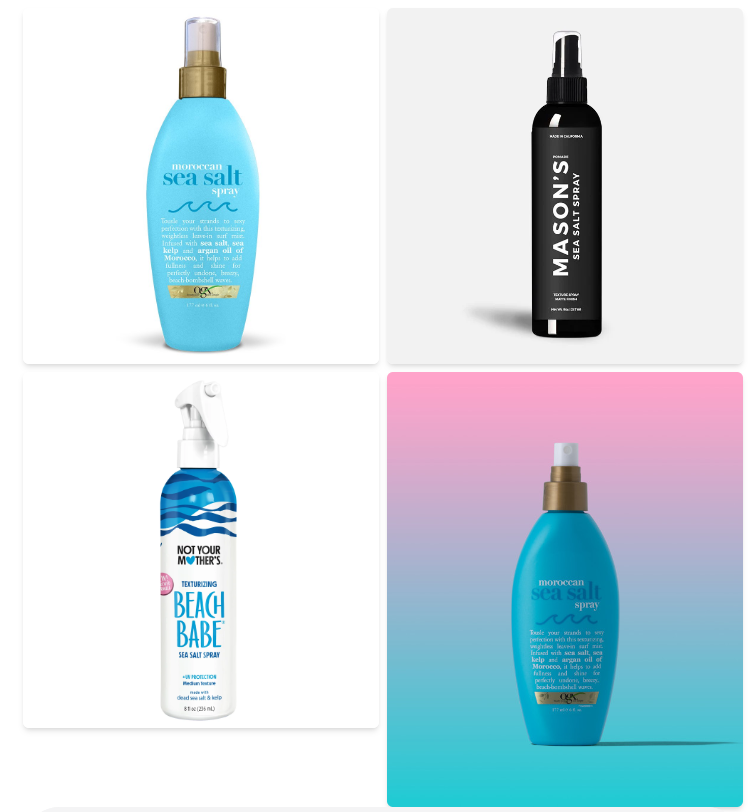
Sea salt spray is a hair product designed to give your locks the same tousled, textured look you’d get after a day at the beach. Comprising mainly of salt water, it often includes other ingredients like coconut oil, algae, or even aloe vera to nourish the hair while providing that sought-after beachy wave.
Personal anecdote: I recall my first encounter with sea salt spray at a local salon. The stylist described it as “the ocean in a bottle,” and after a quick application, I was amazed. My hair had that post-beach volume and wave, even though I was miles away from any coastline.
The beauty of this product lies in its simplicity. It’s a quick solution for those days when you want a relaxed, effortless look without resorting to heat tools or complex styling products.
If you’re exploring hair products, understanding their effects is crucial. Learn more about the potential causes of hair thinning here.
Benefits of Using Sea Salt Spray
The allure of sea salt spray isn’t just about achieving that beachy, sun-kissed look; it’s also about the myriad benefits it offers to various hair types. From adding volume to enhancing natural waves, sea salt spray has become a go-to product for many.
Personal anecdote: On a trip to Bali, I was introduced to sea salt spray by a local hairstylist. She raved about its benefits, and after using it, I was hooked. Not only did it give my hair a natural wave, but it also added a shine that I hadn’t seen in years.
Here are some standout benefits of this wonder spray:
- Natural Texture: It enhances your hair’s natural texture, making it look more voluminous and lively.
- No Harmful Chemicals: Many sea salt sprays are free from sulfates and parabens, making them a healthier choice for your locks.
- Quick Styling: For those on-the-go moments, a few spritzes can transform flat hair into wavy, beach-ready tresses.
Potential Side Effects of Sea Salt Spray
While sea salt sprays have taken the beauty world by storm, offering a quick fix to achieve those dreamy beach waves, it’s essential to be aware of their potential side effects. Like all products, what works wonders for one person might not be ideal for another.
Personal anecdote: I remember my cousin, Lisa, who has naturally curly hair, tried sea salt spray for the first time. While I loved the volume and texture it gave my straight hair, she found it made her curls dry and frizzy. It was a stark reminder that one size doesn’t fit all, especially in hair care.
Dehydration and Loss of Natural Oils
- Sea salt, by nature, is a desiccant, meaning it draws out moisture. While this can give hair that matte, beachy texture, it can also lead to dehydration, especially with frequent use.
- Over time, the lack of moisture can strip hair of its natural oils, leading to dryness, brittleness, and increased susceptibility to breakage.
Concerned about hair dehydration? Discover the role of natural oils in maintaining hair health.
Scalp Irritation and Dandruff
- For some individuals, especially those with sensitive scalps, the salt in these sprays can cause irritation. This can manifest as itchiness, redness, or even a burning sensation.
- A dry scalp can lead to flakiness, which many mistake for dandruff. However, true dandruff is caused by an overproduction of oil, not dryness. It’s crucial to identify the cause to treat it effectively.
Potential for Hair Damage
- While sea salt sprays can give hair a textured look, over-reliance can lead to damage. The salt can open up the hair’s cuticle, making it more porous and prone to damage from environmental factors like sun and pollution.
- Additionally, if used with heat styling tools, the combination can be particularly damaging, leading to split ends and breakage.
While sea salt sprays offer numerous styling benefits, it’s essential to use them judiciously and be aware of potential side effects. Always listen to your hair and scalp, and if you notice any adverse reactions, it might be time to give the product a break.
Does Sea Salt Spray Cause Hair Thinning or Growth?
The beachy waves and textured look that sea salt sprays offer have made them a favorite among many. However, with its rising popularity, questions about its impact on hair health have also surfaced. One of the most debated topics is whether sea salt spray can cause hair thinning or, conversely, promote hair growth.
Personal anecdote: My friend Sarah, who has always had luscious, thick hair, started using sea salt spray daily. Over a few months, she felt her hair was thinning. Concerned, she consulted a trichologist, who shed light on the potential effects of sea salt on hair.
- Hair Thinning: The dehydrating properties of salt can lead to hair becoming brittle over time. Brittle hair is more prone to breakage, which can give the appearance of thinning. Moreover, if the scalp becomes too dry, it can disrupt the hair growth cycle, potentially leading to hair loss.
- Hair Growth: There isn’t concrete evidence to suggest that sea salt sprays promote hair growth. However, some believe that the minerals present in sea salt, like magnesium, calcium, and potassium, can nourish the scalp and hair follicles, potentially promoting growth. It’s essential to note that while these minerals are beneficial, the drying effect of salt might counteract these benefits.
Curious about factors that genuinely promote hair growth? Dive into our article on reversing hormonal hair loss.
However, while sea salt sprays offer aesthetic benefits, their impact on hair health is a mixed bag. It’s crucial to use them in moderation and always pay attention to how your hair and scalp react. If you notice any adverse effects, it might be time to reconsider your hair care routine.
Other Concerns: Dandruff and Hair Damage
While the primary concern for many is whether sea salt spray leads to hair thinning or growth, other potential issues are equally pressing. Two of the most common concerns are the onset of dandruff and potential hair damage.
Personal anecdote: My brother, an avid user of sea salt sprays, once complained about an itchy scalp. On closer inspection, I noticed white flakes on his dark shirts. It was a wake-up call about the potential side effects of overusing these sprays.
- Dandruff: Sea salt can dry out the scalp, leading to flakiness. While these flakes might resemble dandruff, they’re often just a result of a dry scalp. True dandruff is caused by an overproduction of oil and a specific type of yeast that lives on the scalp. However, the itchiness and irritation from a dry scalp can exacerbate dandruff in those already prone to it.
Are you struggling with dandruff? Discover its causes and how to combat it effectively in our in-depth article.
- Hair Damage: The desiccating properties of sea salt can make hair more porous, leading to potential damage from environmental factors. When hair cuticles are raised, they’re more susceptible to damage from the sun, pollution, and even other hair products. Over time, this can lead to split ends, breakage, and a lackluster appearance.
Concerned about hair damage? Learn about the various factors that can harm your locks and how to protect them.
In essence, while sea salt sprays can provide a beautiful beachy texture, it’s essential to be aware of potential side effects. Moderation is key. If you notice any adverse reactions, consider reducing the frequency of use or seeking alternatives.
How to Use Sea Salt Spray Effectively
Sea salt spray has become a staple in many hair care routines, promising that sun-kissed, beachy look without a trip to the coast. However, like any product, its effectiveness lies in its correct application. Using it the right way can make all the difference between gorgeous waves and a hair disaster.
Personal anecdote: I recall a day when I was running late for a meeting. In haste, I drenched my hair with sea salt spray, hoping for quick results. Instead, I was left with a crunchy, tangled mess. It was a lesson learned: more isn’t always better.
Steps to Apply Sea Salt Spray
- Start with Damp Hair: For best results, your hair should be slightly damp. It allows the spray to distribute evenly and helps in achieving that natural wave.
- Shake the Bottle: Ensure all ingredients are mixed well. Some sprays may have oils or other nourishing agents that settle at the bottom.
- Spray at a Distance: Hold the bottle about 6-8 inches away from your hair. This ensures even distribution and prevents over-saturation.
- Use in Moderation: A common mistake is using too much product. Start with a few spritzes and add more if needed.
- Scrunch and Style: After spraying, scrunch your hair with your hands to enhance natural waves. You can also twist sections for a more defined look.
- Let it Air Dry: For a natural finish, let your hair air dry. If you’re in a hurry, a diffuser attachment on your hairdryer can speed up the process without disrupting the waves.
Looking for more styling tips? Discover the do’s and don’ts of using hair products in our comprehensive guide.
Tips for Different Hair Types
- Straight Hair: Sea salt spray can add volume and slight waves. Apply mainly to the lengths and avoid the roots to prevent them from looking greasy.
- Wavy Hair: Enhance your natural waves by applying the spray evenly throughout. Scrunching will give a more defined look.
- Curly Hair: Use sparingly to avoid drying out your curls. It can help in reducing frizz and adding definition.
- Thick Hair: Focus on the mid-lengths and ends. Due to the volume of thick hair, it might require a bit more product for the desired effect.
- Fine Hair: Use a light hand to avoid weighing down your hair. A few spritzes can add volume and texture without making it look limp.
| Hair Type | Application Area | Benefits |
|---|---|---|
| Straight | Lengths | Adds volume |
| Wavy | Throughout | Defines waves |
| Curly | Sparingly | Reduces frizz |
| Thick | Mid-lengths and ends | Enhances texture |
| Fine | Lightly throughout | Adds volume without weight |
Have curly hair and wondering if sea salt spray is right for you? Dive into our article discussing its effects on curly hair.
While sea salt spray is a versatile product suitable for various hair types, its effectiveness lies in its application. By understanding your hair type and following the above guidelines, you can achieve that dreamy beach look without any adverse effects.
DIY Sea Salt Spray Recipes
Creating your own sea salt spray at home can be both fun and rewarding. Not only do you get to customize the ingredients to suit your hair type, but you also have the satisfaction of knowing exactly what’s going into your hair product.
Personal anecdote: I remember a summer vacation when I ran out of my store-bought sea salt spray. Not wanting to give up my beachy waves, I decided to whip up my own version using ingredients from the kitchen. The result? A natural, effective spray that I still use to this day!
Basic Sea Salt Spray Recipe:
- 1 cup of warm water
- 1-2 tbsp sea salt (adjust based on desired texture)
- 1 tsp coconut oil or argan oil (for moisture)
- A few drops of essential oil (like lavender or chamomile) for fragrance
Instructions:
- Mix the sea salt with warm water until fully dissolved.
- Add the oil and essential oil.
- Pour into a spray bottle and shake well before each use.
If you’re into DIY hair care, check out our article on how to make rosemary oil for hair, use these natural remedies for hair health.
For those with curly or drier hair types, consider reducing the amount of sea salt and adding more moisturizing ingredients. Remember, the beauty of DIY is customization, so feel free to tweak the recipe to suit your needs.
Alternatives to Sea Salt Spray for Texture
While sea salt sprays are a popular choice for achieving that beachy, tousled look, they aren’t the only option out there. For those who find sea salt sprays too drying or are simply looking for a change, there are several alternatives that can offer similar texture without the potential drawbacks.
Personal anecdote: My sister, who has fine hair, always struggled with sea salt sprays weighing her hair down. On a whim, she tried a texturizing powder and was amazed at the volume and hold it provided.
- Texturizing Powder: Great for adding volume at the roots and providing a matte finish.
- Dry Shampoo: Besides refreshing hair, it can also add texture and volume.
- Hair Mousse: Offers hold and can enhance natural waves when scrunched into damp hair.
Looking for more hair styling alternatives? Dive into our comprehensive guide on the best hairstyles for thinning hair.
FAQs
When it comes to sea salt sprays and hair care, numerous questions arise. From concerns about hair health to the best ways to use these products, we’ve compiled a list of frequently asked questions to shed light on these topics.
Personal anecdote: I remember attending a hair care workshop where the Q&A session was dominated by questions about sea salt sprays. It was evident that while many loved the product, there was still a lot of uncertainty surrounding it.
Q1: Does sea salt spray cause hair loss?
Answer: While sea salt spray can dry out the hair and scalp, leading to potential breakage, there’s no direct evidence to suggest it causes hair loss. However, excessive use can lead to dryness, which might contribute to breakage and the appearance of thinning hair.
Q2: How often should I use sea salt spray?
Answer: It’s best to use sea salt spray in moderation. Depending on your hair type, 2-3 times a week should suffice. Always ensure you’re moisturizing your hair to counteract any drying effects.
For a deeper dive into product usage and hair health, check out our detailed guide.
Q3: Can I use sea salt spray on colored hair?
Answer: Yes, but with caution. Sea salt can potentially fade color over time, especially if used frequently. It’s recommended to use a color-protecting conditioner or treatment alongside.
Q4: Is sea salt spray suitable for all hair types?
Answer: While sea salt spray can be used on most hair types, those with very dry or brittle hair should be cautious. The drying properties of salt might exacerbate existing hair issues.
Curious about which products suit your hair type? Explore our comprehensive article on hair care for different textures.
Q5: Are there natural alternatives to store-bought sea salt sprays?
Answer: Absolutely! You can create a DIY sea salt spray at home using sea salt, water, and a few drops of essential oils or hair-friendly oils like coconut or argan for added moisture.
Q6: Does sea salt spray protect against UV rays?
Answer: No, sea salt sprays don’t offer UV protection. If you’re spending a lot of time in the sun, consider using a hair product with UV filters or wearing a hat.
Q7: I have curly hair. Will sea salt spray make it frizzy?
Answer: Sea salt spray can potentially dry out curly hair, leading to frizz. However, if used in moderation and combined with moisturizing products, you can achieve defined, beachy waves without excessive frizz.
For more on managing curly hair, dive into our article discussing its care and maintenance.
Conclusion and Key Takeaways
In the world of hair care, sea salt spray has earned its spot as a beloved styling product. While concerns about its effects on hair health exist, understanding how to use it effectively can help you achieve that coveted beachy texture without compromising your locks.
Personal anecdote: As a hair enthusiast, I’ve experimented with various products over the years. Sea salt spray has become a go-to for me, especially during summer months when I want effortless waves.
Key Takeaways:
- Moderation is Key: Overusing sea salt spray can lead to dryness and potential breakage. Use it 2-3 times a week and always follow up with moisturizing products.
- Customization Matters: DIY sea salt spray recipes allow you to tailor the formula to your hair type and preferences.
- Alternatives Are Available: If sea salt spray doesn’t suit your hair or you’re looking for a change, consider texturizing powders, dry shampoos, or hair mousses.
- Hair Health is a Priority: Prioritize the health of your hair by moisturizing, protecting against UV rays, and avoiding excessive heat styling.
- Embrace Your Hair Type: Sea salt spray can work on various hair types, but understanding your hair’s needs and adjusting your routine accordingly is essential.
For a comprehensive guide on maintaining healthy hair, check out our article on the Big 3 Hair Loss Treatment that actually work.
As you navigate the world of sea salt sprays, remember that achieving the perfect look is possible with proper knowledge and care. By following the tips, recipes, and guidelines provided in this article, you can enjoy those gorgeous beachy waves while keeping your hair healthy and vibrant.
- AI Powered Bald Filter Online 2024: See Yourself with No Hair! - January 19, 2024
- Harklinikken Bad Reviews 2024: Analyzing Negative Feedbacks - January 18, 2024
- How to Get the Alex Eubank Hair | Step-By-Step Tutorial 2024 - January 18, 2024

